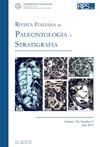THE LOWER BAJOCIAN GAETANI LEVEL: LITHOSTRATIGRAPHIC MARKER OF A POTENTIAL OCEANIC ANOXIC EVENT
IF 1.6
3区 地球科学
Q2 GEOLOGY
引用次数: 3
Abstract
In this paper we document in detail the transition from the Rosso Ammonitico Lombardo to the Radiolarites outcropping at Alpe Turati (Albavilla, Como) in the Lombardy Basin of the Southern Alps. At this location, the Jurassic succession was deposited on a flank of the Corni di Canzo paleohigh: as found on other structural shallow areas, the upper Pliensbachian–Toarcian–Aalenian interval is represented by pseudonodular to nodular marly limestones of the Morbio Limestone and Rosso Ammonitico Lombardo units. In the early Bajocian deposition of biosiliceous sediments is ubiquitously testified by the Radiolarites (Bajocian–Callovian). At Alpe Turati, the interval immediately below the basal green member of the latter unit, consists of a 10 cm thick black shale, pointing to oxygen-depleted bottom waters. Dysoxia persisted during the Bajocian–Callovian as evidenced by dark green stratified cherts. Calcareous nannofossil biostratigraphy indicate an early Bajocian age for the black shale that correlates with the core of a distinct C isotopic negative anomaly also known in various basins outside the Southern Alps. Very dark grey to black lithologies of early Bajocian age have been documented in a few sections from Poland, Corsica and Morocco. We name Gaetani Level the black shale interval in recognition of Maurizio Gaetani’s pioneering and extensive work on Jurassic sedimentary successions of the Lombardy Basin. The association of the Gaetani black shale with a C isotopic anomaly suggests that it could be the sedimentary record of an Oceanic Anoxic Event whose regional to global extension must be ascertained.巴乔期GAETANI低层:潜在海洋缺氧事件的岩石地层学标志
在本文中,我们详细记录了从Rosso Ammonitico Lombardo到在南阿尔卑斯山脉伦巴第盆地Alpe Turati(Albavilla,Como)露头的Radiolaries的过渡。在该位置,侏罗纪序列沉积在Corni di Canzo古高地的侧翼:正如在其他构造浅区发现的那样,上普林斯巴奇阶-托阿尔阶-阿伦阶间隔以Morbio石灰岩和Rosso Ammonitico Lombardo单元的假结节状至结节状泥灰石灰岩为代表。在Bajocian早期,放射性物质(Bajocian-Callovian)普遍证明了生物硅质沉积物的沉积。在Alpe Turati,后一单元的基底绿层正下方的层段由10厘米厚的黑色页岩组成,指向缺氧的底层水域。深绿色层状燧石证明,在巴乔期-卡洛维期,缺氧持续存在。钙质超微化石生物地层学表明,黑色页岩的年龄早于巴焦西阶,与南阿尔卑斯山以外的各种盆地中已知的独特C同位素负异常的核心有关。在波兰、科西嘉岛和摩洛哥的一些地区,已经记录了巴约西亚早期非常深的灰色到黑色的岩性。我们将Gaetani Level命名为黑色页岩层段,以表彰Maurizio Gaetani在伦巴第盆地侏罗系沉积序列方面的开创性和广泛工作。Gaetani黑色页岩与C同位素异常的关联表明,它可能是海洋缺氧事件的沉积记录,必须确定其从区域到全球的延伸。
本文章由计算机程序翻译,如有差异,请以英文原文为准。
求助全文
约1分钟内获得全文
求助全文
来源期刊
CiteScore
3.60
自引率
4.30%
发文量
28
审稿时长
>12 weeks
期刊介绍:
The Rivista Italiana di Paleontologia e Stratigrafia was founded in 1895. It publishes original papers dealing with all fields of paleontology and of stratigraphy, from Italy and the Mediterranean to the Tethys, as well across the globe from China to North America.

 求助内容:
求助内容: 应助结果提醒方式:
应助结果提醒方式:


